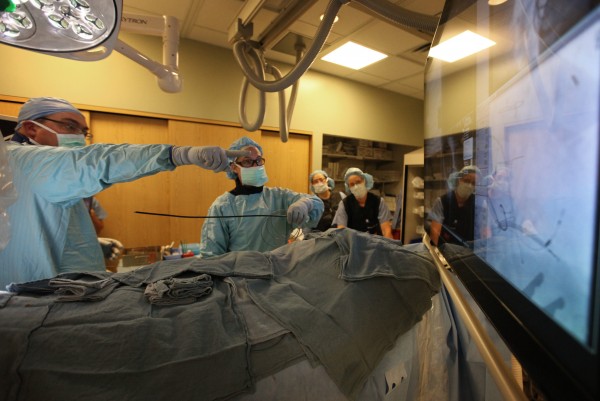Dr. Pierce Vatterott (left) watches a monitor during the removal of four defibrillator leads from a patient at United Hospital in St. Paul, Minn., in June. GlideLight, made by Colorado Springs-based Spectranetics and recently approved by the U.S. Food and Drug Administration, helps make the lead extractions easier.
When a patient is treated at a hospital and released she should know exactly what medications and continued care she’ll need. If she’s underinsured or uninsured, she should be connected to nearby free clinics and drug assistance programs. These are just a few ways to help prevent her from having to return to the hospital with complications.
As political leaders discuss how to make the $486 billion Medicare program more efficient, they have and will continue to press hospitals to reduce readmissions — both to cut costs and improve people’s health. As Maine hospitals work to lower their readmission rates, they can learn from what has worked at other hospitals.
A recent study by Health Management Associates, supported by the Commonwealth Fund, examined what four hospitals — in Utah, Texas, Iowa and Missouri — did to become top performers. The general lessons learned are based on common-sense: Hospitals should target high-risk patients early, improve communication with everyone involved in a patients’ treatment, maintain electronic records in order to coordinate care across different settings, present a treatment plan that the patient understands and maintain contact with high-risk patients once they leave the hospital.
The individual approaches, though, are most interesting. They resulted in the four hospitals having readmission rates in the lowest 3 percent of all U.S. hospitals during 2007 and 2008. Here are a few of the many specific approaches of two of the four hospitals:
Mercy Medical Center in Cedar Rapids, Iowa
• It worked with a competitor hospital and other providers to support a safety-net clinic that serves more than 200 patients each day, reducing the risk that those without insurance will need to be rehospitalized.
• It targets patients likely to experience problems after they leave the hospital; social workers visit all patients over age 80.
• All cardiac patients receive a telemonitoring device when they leave. The devices track vital sign information and send it through a phone line to a nurse who can request follow-up if conditions worsen. When the hospital started using the devices in February 2008, it saw a 47 percent decrease in readmissions and a 57 percent decrease in average length of stay among participating patients.
• The hospital created a program called IPOST to make it easier for health care providers across different settings to honor a patient’s end-of-life decisions. The IPOST tool is signed by a physician and lays out orders that follow the patient among different facilities. It allows the patient’s wishes to be honored — perhaps to carry out his or her last days at home — and prevents interventions to bring the patient back to the hospital.
McKay-Dee Hospital in Ogden, Utah:
• Nurses and care managers are trained to assess a patient’s literacy skills and adjust their care instructions accordingly to make sure they’re understood.
• Physicians are required to have follow-up phone calls or appointments with patients within one week of their discharge from the hospital.
• The hospital schedules follow-up appointments for most patients before discharge.
• Each heart disease patient receives a customized list that describes, in easy-to-understand language, the purpose of each medication and when it should be taken.
Under the Affordable Care Act, the Centers for Medicare and Medicaid Services is scaling back payments to certain hospitals with excess readmissions. For some time, Medicare has declined to pay hospitals if a patient is readmitted within 30 days for the same, original illness, and it could have been prevented. But the federal Hospital Readmissions Reduction Program represents a ratcheting up of efforts to get hospitals to reduce costs.
Starting Oct. 1, 10 hospitals in Maine will be penalized for having what Medicare determined was greater-than-acceptable rates of patients who were readmitted within 30 days of being discharged. No entity wants to be assessed a penalty, but this is a chance for hospitals to identify what they can do better and make necessary changes.
By reducing readmissions — or admissions in general — hospitals will undoubtedly lose money. That’s why companies, hospitals and the government should think differently about how to incentivize efficient, quality medical care. For instance, employers should be open to business models that allow health care organizations to share in savings if the organizations are able to make employees healthier.
As the country moves away from a system where hospitals are paid based on volume and toward one where they are paid based on the quality of their care, it’s important to remember not just the financial savings to programs such as Medicare. This is about people’s well-being. Reducing readmissions saves money, but it also decreases patients’ experiences with pain and discomfort. As Maine and the nation get better at cutting readmissions, the ultimate goal should be to reduce the burden of people’s illness.
Sumber: bangordailynews.com










[…] When a patient is treated at a hospital and released she should know exactly what medications and continued care she’ll need. Selengkapnya […]